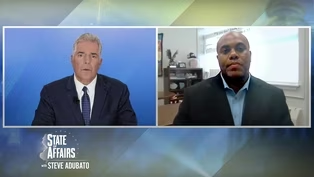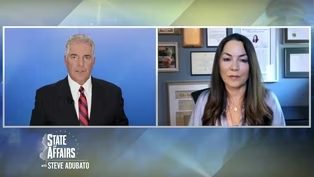State of Affairs with Steve Adubato
Examining Bridge Infrastructure and Safety in New Jersey
Clip: Season 8 Episode 14 | 7m 17sVideo has Closed Captions
Examining Bridge Infrastructure and Safety in New Jersey
Matthew J. Bandelt, Ph.D., P.E., Associate Professor of Civil & Environmental Engineering at New Jersey Institute of Technology, joins Steve Adubato to examine bridge infrastructure and safety throughout New Jersey.
Problems playing video? | Closed Captioning Feedback
Problems playing video? | Closed Captioning Feedback
State of Affairs with Steve Adubato is a local public television program presented by NJ PBS
State of Affairs with Steve Adubato
Examining Bridge Infrastructure and Safety in New Jersey
Clip: Season 8 Episode 14 | 7m 17sVideo has Closed Captions
Matthew J. Bandelt, Ph.D., P.E., Associate Professor of Civil & Environmental Engineering at New Jersey Institute of Technology, joins Steve Adubato to examine bridge infrastructure and safety throughout New Jersey.
Problems playing video? | Closed Captioning Feedback
How to Watch State of Affairs with Steve Adubato
State of Affairs with Steve Adubato is available to stream on pbs.org and the free PBS App, available on iPhone, Apple TV, Android TV, Android smartphones, Amazon Fire TV, Amazon Fire Tablet, Roku, Samsung Smart TV, and Vizio.
Providing Support for PBS.org
Learn Moreabout PBS online sponsorship[INSPRATIONAL MUSIC STING] - We're now joined by Dr. Matthew Bandelt, Associate Professor of Civil & Environmental Engineering at NJIT.
NJIT is one of our higher ed partners.
Good to see you, professor.
- Thanks for having me, Steve.
- Listen, I wanna make sense of this for our audience.
We're doing this several months after the horrific events, the tragic events in Maryland, with the Francis Scott Key Bridge collapsing for obvious reasons, maybe it's not so obvious.
But closer to home, let's talk about New Jersey.
There are 6,800 bridges in the state.
According to the Department of Transportation, 2,541 of those bridges need repair.
What is the difference between needing repair, structurally deficient, and really dangerous, about to potentially collapse?
Please, professor.
- Sure, so a structurally deficient bridge, basically what happens is, is every two years our bridges get inspected.
And a structurally deficient bridge.
- By whom?
Who inspects them?
- By licensed engineers that are sort of hired by the local authority.
It could be the state of New Jersey or a local municipality.
But those engineers do an assessment of the bridge, and if a portion of the bridge that contributes to its main structure, so, for example, the superstructure or substructure is rated as poor, it can move into one of these categories called structurally deficient.
- Okay, was there anything about the bridge, the Francis Scott Key Bridge...
Explain to folks.
What was it that ran into the bridge that caused it to collapse?
- We had a very large vessel that hit that bridge.
About 40 years ago or so, there was a tragic collapse of the Sunshine Skyway Bridge in the state of Florida.
And that set off a series of changes to codes that has sort of emanated into new construction techniques that better protect bridge piers so that these sorts of things can be abated.
- Is that what were called dolphins and fenders?
- Yeah, so there's different types of systems called fenders, there's dolphins, you can create an artificial island around a bridge pier.
And basically what the changes in the code have sort of done is, you have to design either for an impact system or design the bridge pier to be able to withstand these types of forces.
- So when the situation happens, again, the tragic events happen in Maryland, what happens across the country?
What happens in states like New York, New Jersey, Connecticut, states that we're seeing and other states?
Do they redouble their efforts to ensure that the bridges are solidified, stabilized so that they can withstand such impact?
Or could anything have stopped that bridge from collapsing given what hit it and how heavy it was?
- Yeah, so, you know, engineers can always design for something, you know, to be withstood.
The issue is what's economically feasible and, you know, what sort of makes sense.
In the state of New Jersey and, you know, the New York area, what we would sort of wanna do is look at where are the regions where we have large vessel containers moving through.
The main port that we have is the port of Newark, and in that area is the Bayonne Bridge, which actually recently went through some rehabilitation back in 2014.
You know, they raised that bridge, and there was a number of structural enhancements that went along with that as well.
- You know, it's interesting.
The 1991 code, there was a code that, what, in New Jersey upgraded and and raised the standards of what bridges needed to have in place, correct?
- Yeah, so that Sunshine Skyway Bridge in 1980, when that bridge collapse happened, about a decade later, there were changes to the AASHTO Bridge Specification.
AASHTO stands for the American Association of State Highway Transportation Officials.
And that group sets, together, the bridge code that makes its way into each individual state.
- Yeah, but professor, what about the bridges that were built before 1991, before those code upgrades?
- Yeah, so states like New Jersey and owners of bridges, what they do is they go through and they look at, you know, they do sort of a threat assessment and look through and make upgrades as appropriate.
So, for example, when there was that major upgrade that I mentioned before to the Bayonne Bridge, there was also upgrades that were made to the bridge piers too in that area.
- So help folks understand beyond the, again, this is your professional life, you try to understand these issues from an engineering point of view, and it's your profession.
But for the average person, you know, people are asking, "How safe are the bridges?"
And I know it's bridge by bridge, but how can anyone know and be confident about how safe a bridge they're driving over really is?
Where do they get the information?
- So you can go right onto the Federal Highway Administration's website and look up.
- That's the Federal Highway Administration's website.
What does that tell you?
- Yeah, so you can go and look at the bridge condition of any bridge that you want.
So you can type in, you know, the latitude and longitude or look it up state by state or municipality by municipality and see how your bridge is rated and what the conditions are.
But, you know, any bridge that is deemed unsafe, that bridge is closed.
So even though a structure, you know, we might say is in good condition or fair or poor, that means that we need to do some maintenance of preservation.
But if it's unsafe, engineers would close a bridge for sure.
- Just tell us this, do you believe that that website, if people go onto it, as it's up right now, is it in everyday English or is it in government speak?
- It's really pretty easy to look at.
I mean, there's green, yellow, and red for your bridge, and you can look at it year by year.
- Professor, thank you so much.
We appreciate it.
- Thank you very much, Steve.
- You got it.
Stay with us, we'll be right back.
- [Narrator] State of Affairs with Steve Adubato is a production of the Caucus Educational Corporation.
Celebrating 30 years in public broadcasting.
Funding has been provided by Horizon Blue Cross Blue Shield of New Jersey.
The Healthcare Foundation of New Jersey.
The Fidelco Group.
The New Jersey Economic Development Authority.
Wells Fargo.
PSE&G, Newark Board of Education.
PSEG Foundation.
And by New Jersey Sharing Network.
Promotional support provided by New Jersey Globe.
And by New Jersey Monthly.
- (Narrator) Since 1903, PSEG has worked to keep our commitment to customers and communities, to keep your lights on and homes warm.
We’re there when challenges strike like storms or economic uncertainty.
We're preparing for tomorrow by working to replace aging infrastructure, provide carbon free nuclear energy, and deliver energy efficient options to customers.
PSEG, powering progress.
Ameer Washington Addresses The Youth Mental Health Crisis
Video has Closed Captions
Clip: S8 Ep14 | 9m 44s | Ameer Washington Addresses The Youth Mental Health Crisis (9m 44s)
CEO of HISA Talks About Equine Death and Drug Use
Video has Closed Captions
Clip: S8 Ep14 | 10m 56s | CEO of HISA Talks About Equine Death and Drug Use (10m 56s)
Providing Support for PBS.org
Learn Moreabout PBS online sponsorship
- News and Public Affairs

Top journalists deliver compelling original analysis of the hour's headlines.

- News and Public Affairs

FRONTLINE is investigative journalism that questions, explains and changes our world.












Support for PBS provided by:
State of Affairs with Steve Adubato is a local public television program presented by NJ PBS

